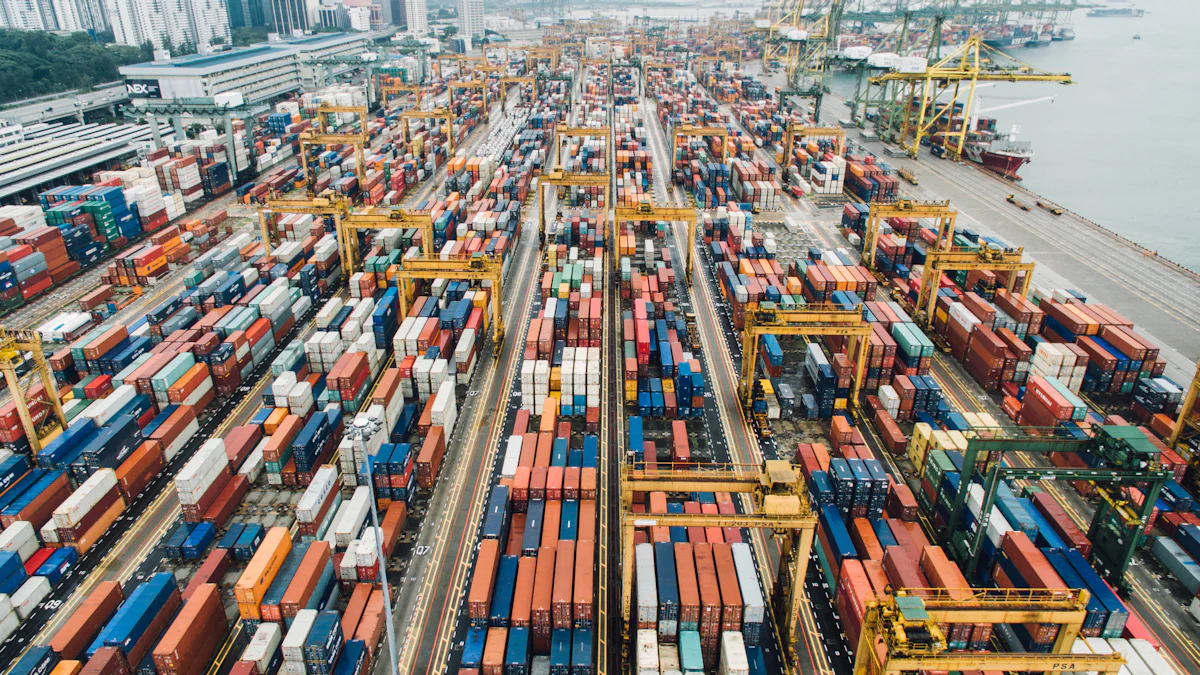How to Mitigate Risks in Supply Chain Logistics

Effective logistics risk management ensures your business stays operational during disruptions. Over the past decade, globalization has made supply chains more interconnected. You now face challenges like managing suppliers across borders, navigating regulatory hurdles, and addressing cyber vulnerabilities. The rise of e-commerce has further complicated logistics, demanding faster deliveries and seamless operations to meet customer expectations.
Key Takeaways
Manage inventory well and talk clearly to deliver faster.
Use different suppliers and locations to keep things running smoothly.
Check for risks often to find problems and plan ahead.
Key Risks in Supply Chain Logistics

Demand for Faster Delivery and Customer Expectations
The demand for faster delivery has grown significantly with the rise of e-commerce. Customers now expect their orders to arrive quickly and accurately. Delivery delays often lead to dissatisfaction, especially during critical events where timing is essential. Factors like inventory shortages, carrier issues, or weather conditions can disrupt delivery schedules. To meet these expectations, you must focus on effective inventory management and clear communication with customers. This approach minimizes delays and ensures customer satisfaction.
Geopolitical Issues and Trade Restrictions
Geopolitical events can disrupt global supply chains, creating challenges for businesses. Recent examples include the microchip shortage and the impact on grain exports from Ukraine. Trade restrictions further complicate logistics by introducing new tariffs and cost structures. To adapt, companies are shifting to on-demand manufacturing and enhancing collaboration among supply chain participants. These strategies help mitigate risks and maintain efficiency despite geopolitical uncertainties.
Shipping Bottlenecks and Transportation Delays
Shipping bottlenecks remain a significant challenge in logistics. During the pandemic, workforce disruptions caused delays, such as the prolonged bottleneck at Yantian terminal. Consumer spending surges also led to container shortages, leaving empty containers stuck in certain regions. Force majeure events, like the Suez Canal blockage, highlight how unpredictable disruptions can halt supply chain operations. Addressing these issues requires proactive planning and real-time tracking to ensure business continuity.
Natural Disasters and Climate Change Impacts
Natural disasters and climate change pose serious risks to supply chain logistics. Events like the California wildfires and Japan’s earthquake disrupted global supply chains, causing billions in damages. Climate change exacerbates these risks, as seen with the Texas freeze that halted semiconductor production. Flooding, hurricanes, and wildfires further strain transportation routes and production schedules. You must develop contingency plans to minimize the impact of such events on your operations.
Cybersecurity Threats and Data Breaches
Cybersecurity threats are increasingly targeting logistics companies. Social engineering, ransomware attacks, and data breaches can disrupt operations and compromise sensitive information. For example, inoperable electronic logging devices caused by cyber incidents can lead to business interruptions. To protect your supply chain, you should implement robust cybersecurity measures and train employees to recognize potential threats. This ensures the continuity of your logistics operations and safeguards your data.
Actionable Strategies for Logistics Risk Management

Leveraging Data-Driven Decision-Making with JUSDA ESG
Data-driven decision-making plays a crucial role in mitigating supply chain interruptions. By analyzing historical data and current trends, you can predict potential risks and develop proactive strategies. For example, companies like Boeing use data analytics to monitor supplier performance and geopolitical factors, enabling them to adjust procurement strategies effectively. Tools like JUSDA ESG provide real-time insights, helping you identify inefficiencies and optimize operations.
Adopting data analytics offers several benefits:
Enhances customer satisfaction and reputation.
Minimizes business disruptions.
To implement these tools effectively, analyze historical shipment data, foster data sharing across your chain, and establish KPIs like order fulfillment rates. Regularly track the tool’s performance and train your team to maximize its features.
Building Adaptable and Flexible Supply Chains
A flexible supply chain ensures you can respond quickly to market changes. Adaptability allows you to handle unexpected demand variations or disruptions. Efficient planning ensures raw materials are available for production, while digital tools provide end-to-end visibility. This visibility guarantees real-time tracking and traceability, enhancing your chain’s performance.
Developing Comprehensive Contingency Plans
Contingency plans are essential for business continuity. These plans should include risk assessments, alternative supplier options, and adaptable logistics networks. For example, maintaining stockpiles ensures operations continue during disruptions. Regularly test and update your plans to address emerging risks and integrate new technologies.
Strengthening Supplier Relationships and Communication
Strong supplier relationships reduce logistics risks. Open communication fosters collaboration and transparency, helping you address challenges effectively. Regularly evaluate supplier performance and align partnerships with your strategic goals.
Investing in Technology and Automation for Business Continuity
Automation enhances logistics efficiency. Technologies like IoT and AI provide real-time tracking and reduce manual interventions. For instance, companies like Amazon use robotics to improve order accuracy and delivery speed. Investing in these advancements ensures your chain remains resilient and efficient.
Best Practices for Proactive Risk Management in Logistics
Diversifying Suppliers and Sourcing Locations
Relying on a single supplier increases your vulnerability to disruptions. Diversifying your suppliers and sourcing locations strengthens your supply chain. This approach ensures operational continuity during unexpected events. For instance:
You gain flexibility to adapt to market demands.
You reduce supply issues by having alternative suppliers ready.
You avoid logistical challenges by spreading production and warehousing across multiple regions.
This strategy also encourages innovation and compliance with regulations. By diversifying, you create a resilient logistics network capable of handling unforeseen risks.
Balancing Cost Efficiency with Risk Reduction
Balancing cost efficiency with risk reduction is essential for effective supply chain management. While cost efficiency improves financial performance, resilience ensures business continuity. Disruptive risks, such as demand fluctuations, can affect multiple areas of your chain. Managing these risks requires good practices, like maintaining the right inventory levels. Instead of increasing inventory, focus on optimizing your logistics processes to handle recurrent risks effectively.
Conducting Regular Risk Assessments and Audits
Regular risk assessments help you identify and address vulnerabilities in your logistics operations. Follow these steps:
Identify risks in your supply chain.
Prioritize them based on their potential impact.
Develop a plan to mitigate these risks.
Implement the plan across your operations.
Continuously monitor and update your risk management strategies.
This proactive approach ensures your chain remains robust and adaptable to emerging challenges.
Collaborating with JUSDA for Seamless Logistics Solutions
Partnering with logistics experts like JUSDA enhances your supply chain's resilience and efficiency. JUSDA offers advanced digital solutions, such as dynamic inventory and risk management, to streamline operations. The JusLink platform provides real-time tracking and end-to-end visibility, enabling proactive issue resolution.
Benefit | Description |
|---|---|
Lower costs | Sharing resources reduces transportation and warehousing expenses. |
Improved efficiency | Streamlined processes minimize errors and delays. |
Increased flexibility | Quick responses to market changes enhance competitiveness. |
Better customer satisfaction | Reliable and faster deliveries improve customer trust. |
Increased competitiveness | Efficient services give you a competitive edge. |
Better access to markets | Collaboration opens new opportunities and customer bases. |
JUSDA combines global reach with local expertise, tailoring solutions to your specific needs. This partnership ensures your logistics operations remain efficient and resilient, even during disruptions.

JUSDA Solutions
To provide you with professional solutions and quotations.
Managing risks in logistics ensures your operations remain resilient during disruptions. You can address challenges like shipping delays, cybersecurity threats, and natural disasters by adopting proactive strategies. Contingency planning and flexible supply chains safeguard logistical company continuity. Effective risk management strengthens your chain and ensures disruption-free supply chain operations. Partnering with JUSDA enhances your business continuity through innovative solutions and expert guidance.
See Also
Essential Strategies for Effective Supply Chain Risk Management
Enhancing Supply Chains Through Strategic Risk Management
Protecting Your Supply Chain from Potential Risks
Navigating Supply Chain Risks: A Comprehensive Guide
Adopting Sustainable Practices for Supply Chain Risk Management
